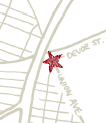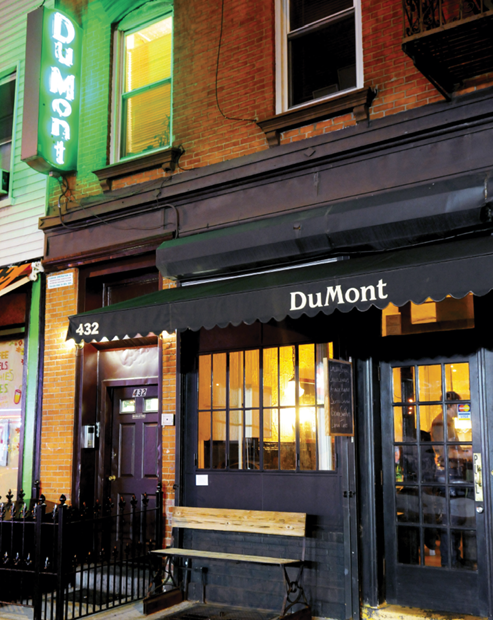WILLIANSBURG


DuMont owner Colin Devlin is a proprietor. Old-school. Irish, of course, and handsome. Easy smile. He likes to serve. He likes to make people happy. He’s the kind of guy who invites you out to his twenty-acre spread in the Delaware Water Gap within an hour of meeting you. You both know it won’t happen, but that’s not the point. It’s the connection that such an offer creates—that’s the point.
A bartender by trade, Devlin has been making those kinds of connections since long before he opened DuMont in a 120-year-old Union Avenue tenement house in May 2001. In some ways it’s an odd mix: Colin Devlin’s earnest hospitality in the heart of Williamsburg, the least earnest place on the planet. Devlin’s aware of this. “I always felt like we were a sobering force in an über-hip situation,” he says with pride. He’s right. The neon sign out front sets the tone right away. Devlin saw it one day hanging over an old appliance store that used to sell DuMont televisions. He just liked the look of the neon and the sound of the word. He asked the owner if he could buy the sign. The guy said if Devlin could find a licensed contractor to take it down, he could have it. And that was that. His restaurant had a name.
Now, almost a decade later, that sign is what people think of when they think of DuMont. They think of chef Polo Dobkin’s food, too, of course, especially the decadent Dumac and Cheese (page 53) and the DuMont burger, a massive sandwich on a brioche bun. (That burger is so beloved that Devlin had to open a second restaurant, DuMont Burger, in 2005 just to handle the overflow.) They think about the garden, an oasis in the concrete desert, and those awesome red-and-black leather seats in the front room. And they think about the extensive nightly specials board, which reaches a little higher and which itself was spun off into yet another restaurant, Dressler (page 114), in 2006.
It’s an impressive little empire for a guy who not all that long ago was a bartender living in the dusty shell that would become his flagship restaurant. “The last month before opening, I was sleeping on the banquette,” he recalls wistfully, knowing he’ll never get that ragtag feeling back. “I think it was table one, if anyone’s keeping score at home.”

Hungry? You’d better be. “The mac and cheese!” exults chef Polo Dobkin. “It’s a gut-buster, man. Even when I was like twenty-one or twenty-two, at the height of my eating prowess, I don’t think I could have put down a burger, fries, and a mac. But people do that here—routinely.” This is a deeply satisfying, devil-may-care preparation, made with love and a classic mornay sauce. “That’s the secret,” Dobkin says, though there really isn’t one. “No truffle oil, no weird stuff. Make a good sauce, buy good cheese. That’s it.”
1. Preheat the oven to 400°F.
2. Bring a large pot of salted water to a boil and cook the pasta al dente, according to the package directions. Drain, toss with the olive oil in a large bowl, and set aside to cool.
3. Meanwhile, combine the milk and cream in a medium saucepan over medium-low heat; bring to a gentle simmer.
4. Melt the butter in a large, heavy-bottomed pot over medium heat. Add the flour and whisk until the flour is fully incorporated and the mixture is smooth. Continue mixing with a wooden spoon until the mixture is a pale golden color, about 4 minutes. Slowly add the hot milk and cream mixture to the flour mixture, whisking constantly to incorporate. Bring to a simmer, whisking occasionally to keep the mixture from burning. Add half the Gruyère and half the cheddar and whisk until the cheese has melted and the sauce is smooth. Season to taste with salt and pepper.
5. Add the cooked pasta and toss well to combine. Pour the pasta into a buttered 9 x 13-inch baking dish or 3-quart gratin dish. Top with the remaining Gruyère and cheddar and sprinkle with the bread crumbs. Bake for 20 to 25 minutes, or until golden and bubbly. Allow the mac and cheese to rest for 5 minutes before serving.
SERVES 6
1 pound radiatore, elbow macaroni, or fusilli
2 tablespoons extra-virgin olive oil 2 cups whole milk
2½ cups heavy cream
8 tablespoons (1 stick) unsalted butter
½ cup all-purpose flour
½ pound Gruyère, grated, divided
½ pound sharp white cheddar, grated, divided
Coarse salt and freshly ground black pepper
¼ cup unseasoned bread crumbs
SERVES 6
For the crumbs
2 cups all-purpose flour
1 cup sugar
½ teaspoon salt
½ teaspoon ground cinnamon
10 tablespoons (1¼ sticks) unsalted butter, melted
For the blueberries 5 cups fresh blueberries ⅔ cup sugar
1 tablespoon freshly squeezed lemon juice
1 tablespoon cornstarch
Vanilla ice cream, for serving
The cobbler is the anchor of DuMont’s dessert menu, says chef Polo Dobkin. “Because we have a younger clientele, I think it’s really important to serve food that people can connect to, that they have a history with.” When you scoop the filling into the ramekins, leave plenty of room for the crumbs—there should be a thick, crunchy layer—but be sure to let some berries poke through for color.
1. To make the crumbs, combine the flour, sugar, salt, and cinnamon in a large bowl. Mix well to combine. Drizzle the mixture with the melted butter and, using your hands, mix until all ingredients are evenly incorporated and you have loose crumbs. Set aside.
2. To make the filling, place the blueberries, sugar, and lemon juice in a nonreactive saucepan over medium heat. Simmer, stirring occasionally, until the blueberries have broken down, 10 to 15 minutes. In a small bowl, combine the cornstarch with 2 tablespoons cold water; mix until no lumps remain. Slowly stir the cornstarch into the simmering blueberries. Cook for 30 seconds, or until slightly thickened.
3. Preheat the oven to 350°F. Spoon the blueberries into six 6-ounce ramekins, leaving about ¾ inch at the top. Crumble a generous amount of the crumb topping over the blueberries to cover.
4. Place the ramekins on a rimmed baking sheet and bake until the crumbs are golden to dark brown, 20 to 25 minutes.
5. Cool for at least 30 minutes before serving. Serve with vanilla ice cream.